ICG Longbow Senior Secured UK Property Debt Investments Ltd (LON:LBOW) offers exposure to the UK real estate debt market through investments in senior secured whole loans. This year, LBOW has continued the evolution of its portfolio under the revised investment policy (adopted in 2017). This is now enabling LBOW to reinvest its funds in higher-yielding loans while maintaining an LTV at portfolio level well within the target range. After a slower than expected start, LBOW’s deal activity recently picked up with two new deals closed so far this year on top of short-term extensions and/or repricing of several existing loans. The company’s encouraging investment pipeline allows it to more than absorb the cash from maturing loans.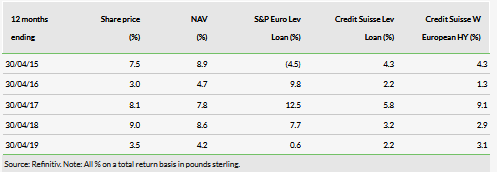
Investment strategy: Targeting full dividend cover
LBOW targets an annualised dividend of 6p per share (1.5p paid quarterly) based on income generated on a portfolio of good-quality, defensive and predominantly fixed-rate senior secured UK real estate whole loans in the mid-market space. Since H214, LBOW has been able to sustain this payout level even though this recently required utilisation of retained earnings and capital due to the current portfolio transition. The company is improving the coupon and fee income on its portfolio (to fully cover the dividend payments) based on recent transactions and its new deal pipeline of c £50m, which are accretive to LBOW’s average coupon rate.
Market outlook: Office and industrial sectors resilient
Brexit negotiations, along with more muted economic data, provides a level of uncertainty influencing the UK commercial real estate market. That said, the industrial segment so far remains strong, while the office market has proved to be more robust than expected. Retail continues to struggle, particularly due to the continued expansion of e-commerce. However, LBOW has little exposure to this sector. Total new commercial real estate (CRE) lending stood at £49.6bn in 2018 (up 12% y-o-y), with lending margins remaining broadly stable, though some downward pressure was visible in selected market segments.
Valuation: Offering a dividend yield of c 6%
LBOW’s shares are currently trading broadly at par with last reported NAV (as at end-April 2019). The fund has consistently delivered a 6p dividend per share on an annualised basis, which currently represents a c 6.2% yield. As part of the dividend is currently paid out of capital, LBOW’s NAV total return is below its dividend yield at present (4.2% on a trailing 12 months basis as at end-April 2019).
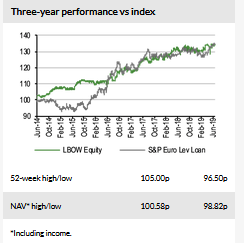
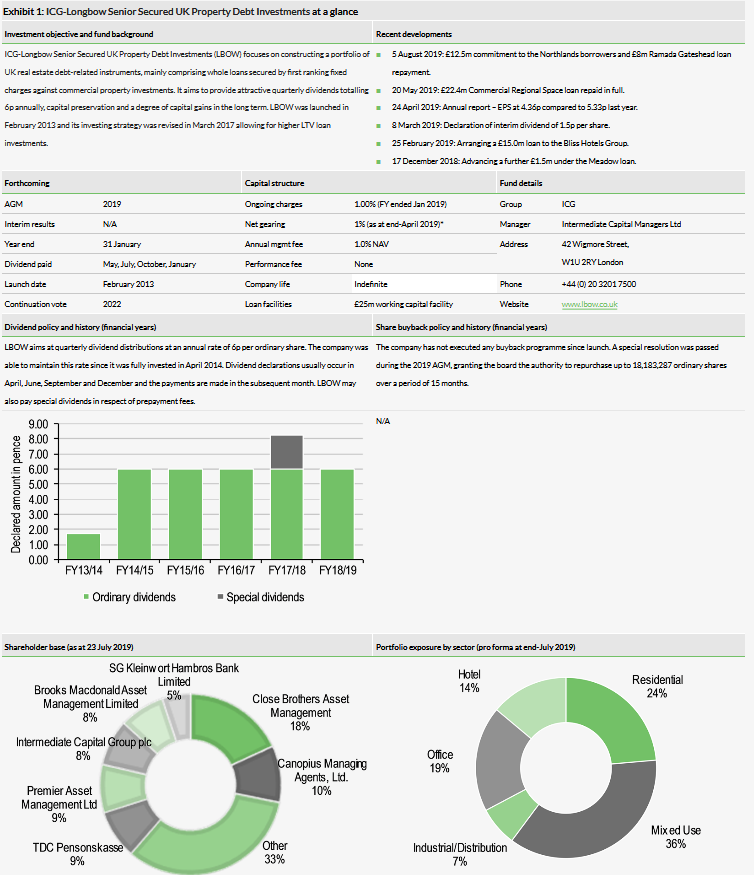
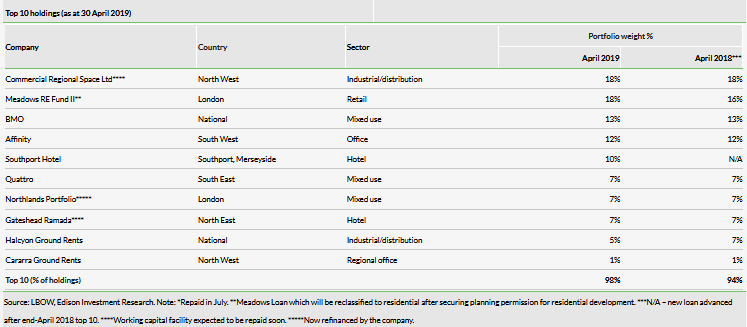
Fund profile
LBOW is an investment fund domiciled in Guernsey that was launched in February 2013 and invests in a diversified portfolio consisting of good-quality, defensive and predominantly fixed-rate senior secured UK commercial real estate (CRE) loans. LBOW considers the range of £10–25m for individual loan size as an attractive market niche, as it is out of reach for small private lenders, but also too small for banks and larger debt funds.
LBOW targets annualised dividend payments of 6p per ordinary share earned on the portfolio of senior secured whole loans in the UK mid-market space. Recently, these payments were partially paid out of retained earnings and capital rather than based entirely on coupon income as its investment portfolio has continued to transition. To achieve its stated objective, LBOW broadened its CRE debt investment spectrum back in 2017, particularly by raising the upper LTV limit at the portfolio level from 65% to 75% and to 85% on individual loan level (though loans with LTV exceeding 80% may not constitute more than 20% of gross asset value). As a significant part of the loans originated under the previous investment policy started to mature only recently, LBOW’s loan portfolio does not fully reflect the new investment opportunities yet. However, the recently announced transactions and its current deal pipeline (discussed in detail in the later part of this report) should facilitate LBOW’s full transition to the new investment approach.
The aforementioned investment policy adjustments result in an increased overall risk profile of the fund, but also provide investors with greater diversity and easier access to new debt market segments. The investment adviser expects a wider investment universe to allow LBOW to allocate assets in senior secured whole loans positioned on the LTV/IRR map (IRR of c 6.0–10.0% pa, see Exhibit 2), which are typically higher LTV loans but still secured by a first ranking mortgage on the underlying properties. Importantly, LBOW places great emphasis on the potential to improve the financial metrics of each loan through enhancement of the income streams generated by the underlying properties with asset management initiatives such as refurbishment, expansion or conversion.
LBOW’s investment policy allows for asset allocation of up to 30% in private real estate debt funds managed or advised by ICG-Longbow (LBOW’s investment adviser) or its associates, provided that none of the funds represents more than 20% of LBOW’s portfolio. In Q119, the company completed due diligence on a potential £25m investment in the most recent ICG-Longbow private fund (see the current portfolio positioning section for more details) and the board hopes to make an announcement on this potential investment in coming months.
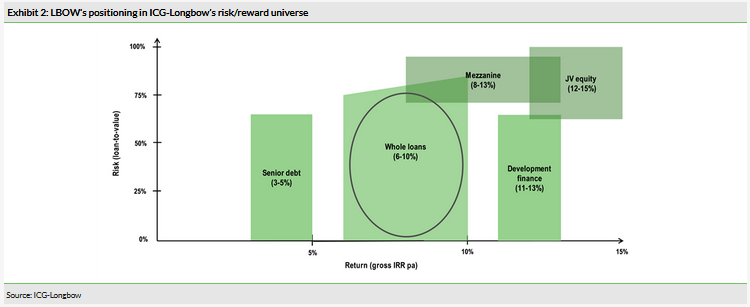
LBOW was originally created with an investment horizon of around five years and the initial portfolio consisted of loans with similar terms, including maturity. Consequently, a significant part of LBOW’s earlier investments have already been repaid or are approaching maturity, requiring high-volume reinvestment activity to minimise the cash drag and allow for dividend distributions out of income rather than capital. The investment adviser intends to avoid such ‘maturity cliffs’ in the future and therefore targets a well-balanced maturity profile reflecting the long-term, evergreen concept. Consequently, investors should expect an average maturity of three to five years at the portfolio level and an average unexpired term of around two to three years, once the transformation is completed. The most recently announced transactions all have loan terms within this range.
The fund manager: Intermediate Capital Managers
LBOW is managed by Intermediate Capital Managers (ICM), which is part of Intermediate Capital Group, an LSE-listed specialist asset manager with 30 years of experience in private debt, credit and equity and €37.1bn in assets under management (AUM) as at end-March 2019 (invested both on behalf of third-party investors and on its own balance sheet). Intermediate Capital Group’s UK real estate debt investments are managed by ICG-Longbow (ICGL), which was established in 2006 and operates through ICM. ICGL’s team consists of 31 members, including 20 investment professionals and eight members responsible for credit risk management, portfolio monitoring and fund operations. ICGL’s seven investment directors have an average of 24 years’ experience in direct property, financing or investment management. ICGL has a dedicated senior debt investment team, consisting of four members including two qualified accountants and a chartered surveyor. It is important to note that ICGL’s expertise covers a solid understanding of both the debt markets and the UK property markets. For a detailed track record, please refer to our initiation note on LBOW.
The manager’s view: Brexit fears are an opportunity
LBOW’s existing loan portfolio continues to perform in line with management’s expectations, with risk well diversified at the portfolio level by sector and region, and negligible exposure to the troubled retail sector. Investments are predominantly backed by multi-property or multi-tenanted securities and where appropriate interest is supported by fully funded cash reserves.
Current sentiment in the UK investment market has been mainly shaped by ongoing Brexit uncertainty, which is affecting business and consumer confidence. The appointment of Boris Johnson as Conservative Party leader and Prime Minister has made a disruptive ‘no deal’ scenario more likely, albeit both the UK and European Union have stated they wish to avoid this. Further uncertainty, or ongoing delay in reaching an agreement, may have a negative impact and the labour market, inflation and the Bank of England’s interest rate policy could all be affected by the outcome of the negotiations. The same applies to the property investment market, where transaction volumes fell notably in the first half of 2019.
Still, the investment adviser believes that periods of volatility and downturns in the property market (despite their potential adverse impact on property values and LTVs) can provide attractive investment opportunities for managers, skilled in identifying strong sponsors and backing deliverable business plans.
Market outlook: UK CRE lending market still robust
The UK real estate markets continue to exhibit varying performances among the respective segments, with the broader market being somewhat affected by the Brexit uncertainty as well as more muted economic data. The all-property capital values rose by 2.1%, posting 7.5% total returns in 2018, down from 5.2% and 10%, respectively in 2017.
Conditions in the London office market in late 2018 and in 2019 to date have proved to be better than expected, with the Brexit impact being relatively muted as a result of strong tenant demand coupled with limited office supply (with not more than a year’s supply of office space in the City and the West End at present according to Savills data). Transaction volumes in 2018 exceeded the 10-year average by 29%, driven by the Central London market, where overseas purchasers (particularly from the Far East) seem to be immune to uncertainties related to Brexit. Similarly, core regional cities, such as Birmingham, Bristol, Edinburgh and Manchester, remain undersupplied amid the scarcity of new office projects and low development over several years. The regional markets also seem attractive from the perspective of mixed-use projects, according to Savills. Similarly, recent comments from Regional REIT suggest that regional office and light industrial markets remain robust, with positive supply/demand dynamics in occupational markets. The broader macroeconomic and political factors may result in a slight decline in UK office investments and occupier activity in 2019 (although no decline in transaction activity in London was visible in Q119, according to Starwood European Real Estate Finance). That said, the effect should be rather moderate than very severe given the still solid business confidence. This is also illustrated by the current capital value growth expectations implied by the IPF UK consensus forecast for the broader UK office market, which currently stand at -1.7% in 2019 and -1.3% in 2020. Together with expected year-on-year rental growth of 0.4% and 0.3%, respectively, this would translate into a total return of 2.4% in 2019 and 3.1% in 2020. Interestingly, these expectations have improved somewhat versus the summer 2018 edition.

The UK industrial sector continues to perform well, posting all-time high transaction volumes amounting to £8.4bn in 2018, with IPF UK consensus implying a total return of 7.2% in 2019 and 5.7% in 2020. This should be assisted by both rental and capital growth. The ecommerce revolution should continue to support demand for industrial and logistics space in 2019. Take-up in the UK industrial market reached 35.9m sq ft. in 2018, which is a 30% increase vs 2017 and the highest level since 2008, according to Cushman & Wakefield. Meanwhile, the commercial real estate market as a whole should post a 2.8% y-o-y capital value decline in 2019, according to IPF consensus. This is confirmed by a survey conducted by Link Asset Services published in March 2019, which suggests that 75% of respondents expect CRE prices to decline by more than 2.5% in 2019.
In contrast, the retail sector remains negatively affected by several factors, including the continued expansion of e-commerce as well as employee cost pressures. This has also impaired investment volumes in the retail real estate market (28% below the 10-year average according to Lambert Smith Hampton), with CBRE expecting these to remain muted well into 2019 (see CBRE’s UK Real Estate Market outlook 2019). In this environment, investors are likely to focus on niche sectors, such as pubs, leisure and roadside retail. Moreover, redevelopment of underperforming retail space should become more prevalent in 2019. According to market expectations included in the spring 2019 edition of Investment Property Forum (IPF) UK consensus forecast report, the retail real estate segment should experience a meaningful capital value decline over the period 2019–21, accompanied by a low-single-digit rent reduction per year (see Exhibit 3). It should be noted that LBOW’s exposure to retail is essentially nil, following the recent grant of planning permission for a major residential development on the site securing the Meadows loan.
The property lending market overall remained overall robust in 2018, as illustrated by the findings of the recent UK CRE lending report published by Cass Business School. New CRE lending for 2018 stood at £49.6bn, up 12% y-o-y. This compares with a 13% y-o-y drop in property transactions to £54bn reported by CoStar. Still, this should be considered against a strong 2017, with property transaction volumes in 2018 being still quite solid, encouraging further debt origination. CRE lending margins remained overall stable as well. There has been some pressure on pricing for senior loans secured by prime property at low LTV ratios (Cass reported that five-year senior lending margins went down to 174bp in 2018 from 188bp in 2017). Moreover, average margins in the broad whole loans space (which is the prime comparative market for LBOW) have compressed somewhat as well in the beginning of 2019, according to the recent Link Asset Services survey. Still, the margins on whole loans originated by debt funds remained above 600bp, translating into a coupon rate of c 7% (broadly in line with LBOW’s new lending opportunities). It is also important to note that credit spreads in the CRE whole loan space are generally deal-specific (ie they vary on a deal by deal basis) and LBOW has highlighted that it has not experienced any meaningful narrowing of spreads lately.
In 2018, there was an increase in capital looking to be deployed in the CRE space, translating into greater competition among lenders. However, lenders were more cautious for those cases with higher market and sectoral risks, as well as value-add lending (showing stronger preference for long-term core income lending). This may provide higher return opportunities for players such as LBOW.
Asset allocation
Current portfolio positioning
LBOW’s portfolio as at end-April 2019 was relatively concentrated (10 loan investments) and remained broadly stable during the last 12 months. One loan was repaid (the £6.57m Hulbert loan) and one new transaction closed (a £15.0m commitment to Bliss Hotel Group). The aggregate principal advanced increased from £114.3m to £121.4m, the average portfolio LTV reached 63.1% (61.2% as at end-April 2018) and the weighted average interest coverage ratio (ICR) decreased slightly to 203% (211% in 2018).
Whilst seven loans from the portfolio at end-April 2019 with an aggregate outstanding balance of c £84.0m recently matured or will mature in the coming months, translating into a considerable cash position to be reinvested, the company’s recent announcements suggest the reinvestment process is well underway. The £22.4m Commercial Regional Space loan as well as £8.0m Gateshead Ramada loan have already been repaid and the company has used part of these proceeds to reinvest in the £12.5m Northlands portfolio refinancing (with the commitment raised from the previous £8.5m). Moreover, LBOW plans to advance a new £15.3m hotel portfolio loan in the coming weeks.
The £15.8m BMO loan had an original maturity in April 2019 but we understand that it is subject to a short-term extension on more favourable conditions. LBOW has also concluded a few further short-term extensions (Halcyon and Carrara) with these loans maturing in December 2019. Finally, the £21.5m Meadows loan will mature in January 2020. Overall, the company is facing approximately £45m of repayments in the next six months but has a direct investment pipeline of £50m and a potential investment in an ICG-Longbow private fund of up to £25m.
Other loan investments held at end-April 2019 include a £16.2m commitment made in February 2018 (Affinity), of which £15.9m has already been advanced. It is secured by a five-storey office block in Bristol, with a total leasable area of 114,364 sq ft occupied by 10 tenants, paying £1.24m rent pa. The latest £1.5m has been advanced under the capital expenditure tranche in respect of the ongoing refurbishment works in Q418. In Q119, a further £0.5m commitment was made to the borrower. The other two loans in LBOW’s current portfolio are Southport Hotel and Quattro with an outstanding balance of £12.6m and £9.0m, respectively. The latter is the only loan that exceeds the 80% LTV threshold (83.7% at end-April 2019) and represents only 7.6% of GAV, within LBOW’s limit of 20% under the current investment strategy.
As at end-April 2019, LBOW was fully invested, with £2.3m held in cash but at the same time £3.5m drawn under the working capital facility in order to fund the Southport Hotel loan investment. This loan facility enables LBOW to incur debt up to 20% of the portfolio, subject to a £25m cap. It provides LBOW with some degree of flexibility in terms of the timing of new loan investments and the reinvestment of proceeds from maturing loans, helping to minimise the potential cash drag and stabilise income streams. These features will be particularly important in the upcoming periods as the portfolio reinvestment process continues. The credit line should allow LBOW to bridge a potential gap between advancing new attractive loans and the maturity date of current loan investments. It could also be helpful in case the total investment volume of identified targets exceeds available cash, as it would allow LBOW to seize additional opportunities and raise new share capital at a later stage to refinance these investments if necessary.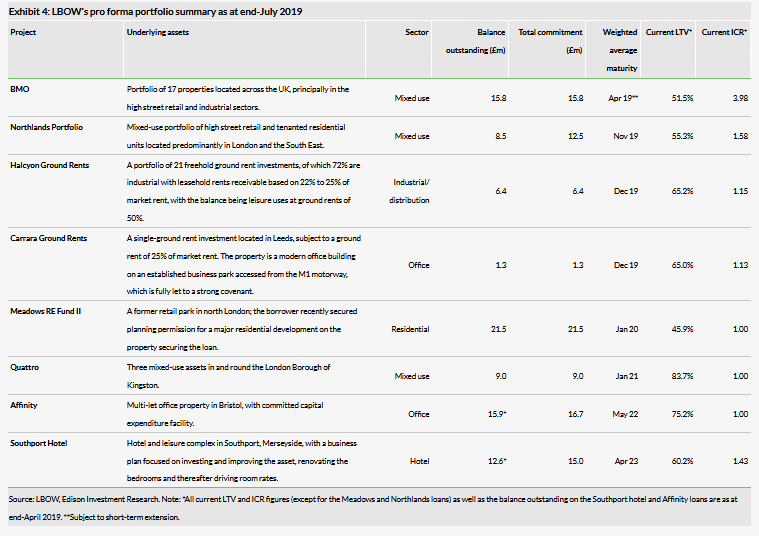
As a result of the multi-year investment horizon of historic assets the strategic shift implemented in March 2017 (please refer to our initiation note) have not been visible until just recently when the weighted average coupon rate at portfolio level rebounded to 7.19% as at end-April 2019 from 6.31% as at end-April 2018 (see Exhibit 5). Having said that, the main driver behind this is the successful repricing of two low-coupon legacy loans (Commercial Regional Space and BMO) with an outstanding balance of £38.2m. This is a short-term improvement only, as the £22.4m Commercial Regional Space loan has already been repaid. In the medium term, based on recent announcements and the current deal pipeline, management expects a continued improvement in the weighted average coupon rate, supplemented by contractual arrangements and exit fees, together with ad hoc prepayment fees and the possibility of profit-sharing arrangements with its loan sponsors.
New investments on the horizon
The pace of LBOW’s new loan investments over the last 12 months was behind the investment manager’s initial expectations. We note that successful closing of new transactions is particularly important as the company approached a maturity cliff in its existing portfolio. As at end-April 2019, new loans amounting to £18m (gross) have already been approved and were moved to the solicitors’ hands to complete these within the next three months (see Exhibit 5). These include a commitment to fund a new £15.3m loan secured by a hotel portfolio which should be executed in August (following the redemption of the £8.0m Ramada Gateshead loan). All these loans carry a weighted average coupon in excess of 7.4% (excluding arrangement and exit fees), as well as an expected LTV at c 70% and average loan term at three years.
We understand that LBOW’s current deal pipeline stands at around £50m. Moreover, the board is analysing an additional £25m investment into the most recent ICG-Longbow private fund, which could improve portfolio diversification and the return profile. The due diligence procedure has already been finalized, opening the door to deal completion. Assuming all the pipeline deals are completed as planned, essentially all proceeds from loan repayments, as well as the entire working capital facility, would be utilised. This would basically represent completion of the portfolio transformation under the current investment policy, which would translate into higher coupons (together with arrangement and exit fees) restoring full dividend cover, improved loan duration, but potentially leading to higher LTVs.
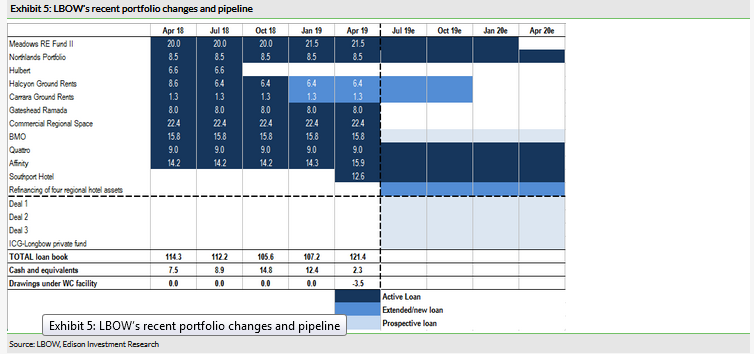
Performance: Affected by ongoing portfolio transition
LBOW does not follow any particular benchmark. Nevertheless, we have decided to compare LBOW’s returns with a broader European debt index for reference. An analysis of fund returns over the past five years shows that LBOW was able to slightly outperform the S&P European Leveraged Loan index we have selected, with annualised total NAV return of 6.9% (as at-end April 2019) compared with 5.1% for the benchmark. LBOW’s share price performance was also slightly ahead of the benchmark at 6.2% pa. Importantly, from the beginning of this period LBOW’s portfolio was already fully ramped up. In conjunction with average ongoing charges of c 0.7% pa and advisory fees of 1.0% pa, reported historically by LBOW, this translates into a gross return of c 8.0–9.0% pa.
In the short term, the company’s performance was influenced by the portfolio transition and some delays in the reinvestment of proceeds from maturing loans. As a result, LBOW’s 12-month NAV total return at end-April 2019 stood at 4.2%, ie below its dividend yield of around 6.0%. This illustrates that the coupon income from loan investments was not sufficient to cover LBOW’s dividend payments in this period, although the board is focused on restoring full dividend cover in the medium term, as indicated in the most recent fact sheet and annual financial statements.
Trading broadly in line with NAV
In the first three years since launch, LBOW’s shares traded at a c 2–6% premium to NAV. As the weighted average coupon rate at portfolio level became more moderate and the company initiated shareholder discussions around the revision of its investment policy back in 2016/17, the premium diminished and the shares started trading around NAV within a ±3% range. Following adoption of the revised strategy, the shares traded at a minor low- to mid-single digit premium to NAV, which has now turned into a minor 1.4% discount.
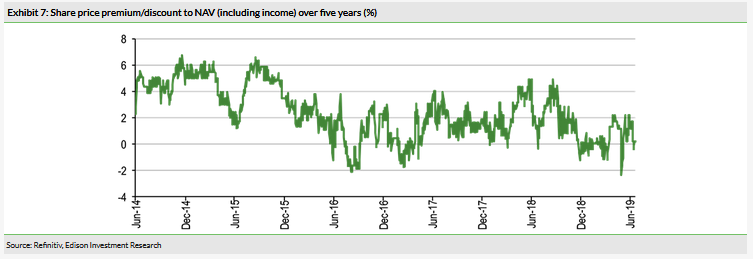
Capital structure and fees
LBOW is charged a management fee by ICM amounting to 1.0% of NAV pa, with a quarterly payment in arrears. Additionally, the expenses incurred while carrying out portfolio management activities, directly related to LBOW’s business, are reimbursed to the investment manager. These include legal, accounting, consultancy and other professional fees and expenses. Historically, total ongoing charges, excluding investment advisory fees, stood at c 0.5–0.6%, but almost doubled in 2017 and 2019, reaching c 1.0% in each of the periods. The increase was driven by legal and professional fees amounting to £373k and £413k respectively. These largely represent non-recurring expenses related to placing programmes and EGM. Going forward, the ongoing charges ratio (including management fee) should stand at around 1.75–1.80% pa.
LBOW’s maximum leverage level under the current investment policy is 20% of NAV. LBOW will use its available debt facilities to minimise the return-dilutive effects of uninvested cash without meaningfully increasing its risk profile. The fund has recently secured a working capital facility with OakNorth Bank, which will enable it to incur debt up to 20% of the portfolio, subject to a cap of £25m, at a variable interest rate of 3M Libor + 3.95%. This is an important step which provides LBOW with some degree of flexibility with respect to the timing of new loan investments and reinvesting proceeds from maturing loans, helping to minimize potential cash drag and stabilize income streams.
On 24 May 2018, the company opened a placing programme covering up to 100m ordinary and/or C shares (compared with 121.3m of shares outstanding at that time). However, no new shares were issued within the placing programme. The AGM held on 2 July 2019 granted management permission to allot and issue equity securities not exceeding 14.99% of the total share count, calculated on a fully diluted basis. The permission expires in 15 months, unless it is renewed or revoked by extraordinary resolution. This timeline and issue size should enable the board to complete the portfolio restructuring process and potentially pay back the debt facility, if required. At the same AGM, it was agreed that the board is allowed to conduct a share buyback, amounting to 14.99% of all the ordinary shares. The authority will expire in 15 months, but it can be revoked earlier, at AGM held in 2020.
Dividend policy and record
LBOW pays dividends to ordinary shareholders on a quarterly basis, usually declaring them in April, June, September and December, with payments being made in the following month. The company has been able to meet the targeted quarterly payments of 1.5p per share since H214, ie approximately since being fully invested. However, it is worth noting that recently these payments were not completely covered by LBOW’s income and required the utilization of retained earnings. In Q418, the latter had been exhausted and the company started supplementing the dividend payout with capital (0.47p per share in Q418). The board is fully committed to maintaining the current dividend level and LBOW will keep utilizing its capital to sustain the current dividend level until the income on its portfolio becomes sufficient to cover the dividends. In January 2019, the board set the timeline for this to occur within next three quarters, as the legacy loans should have already been replaced with new, higher-yielding investments by then. This stance seems to be confirmed by recent transactions and the new deal pipeline including four new transactions in solicitors’ hands, totalling £18m with a weighted average coupon of over 7.4%.
LBOW still aims for total dividend payments of 6p pa. Assuming a broadly stable NAV per share at c 100p (with all excess profits from arrangement and prepayment/exit fees paid out in special dividends), this would imply a dividend yield of c 6.0%. After adjusting for the non-recurring expenses related to the prospectus/share placement incurred in the last two years, LBOW’s total expense ratio (including both advisory fee and other ongoing charges) should stand at around 1.75–1.80% of NAV going forward. This implies that the return on LBOW’s portfolio would have to reach around 7.8% to cover the dividend payments. This is slightly ahead of the current weighted average coupon rate at portfolio level (7.19% at end-April 2019), and is likely to be higher than the coupon rate of LBOW’s existing deal pipeline (more than 7.4%, as mentioned above). Although the company is likely to realize some positive leverage effects from the OakNorth Bank facility (at low- to mid-double-digit basis points level), this should constitute a short-term effect only as LBOW’s investment policy does not assume levering up the portfolio permanently. However, the company normally also receives contractual arrangement and exit fees equating to normally 0.5% to 1.0% per year, which (together with coupon income) should translate into full dividend cover once the portfolio transition is complete. Having said that, we acknowledge that the breathing space in terms of excess return over the 6p dividend will be rather limited. On the other hand, LBOW loans also have certain prepayment protection in place, which may provide additional returns in the case of early repayment and in certain instances loans may carry profit-participation component (eg the Quattro loan).
Peer group comparison
LBOW operates in the AIC Property - Debt sector, which contains funds focused on commercial and/or residential real estate debt investments in the UK and continental Europe. These include TOC Property Backed Lending, Real Estate Credit Investments and Starwood European Real Estate Finance. Moreover, for the performance comparison in Exhibit 9, we have decided to include two funds investing in the broader space of asset-backed loans (Hadrian’s Wall Secured Investments and RM Secured Direct Lending), as well as GCP Asset Backed Income Fund, which is investing predominantly in UK-based fixed and floating rate loans secured against cash flows and/or physical assets. Finally, we added UK Mortgages, which is investing in a diversified portfolio of UK residential mortgages. Exhibit 8 presents comparison of the relevant peers vs LBOW in terms of their investment policies.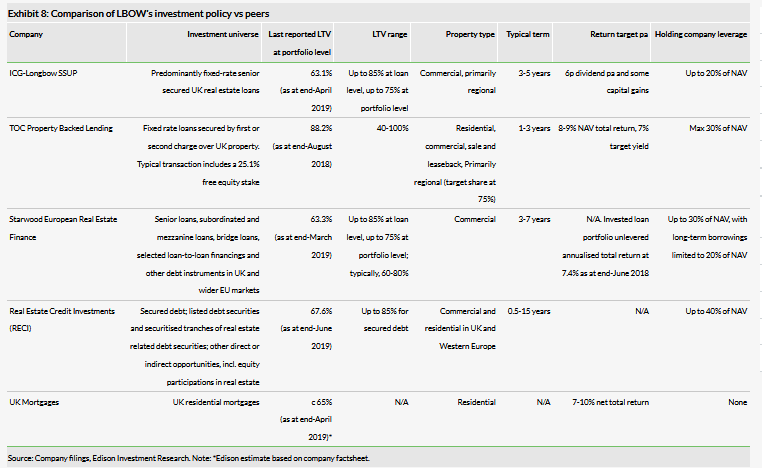
In Exhibit 9 we present the fund’s one-, three- and five-year performance against its peers. LBOW’s one-year NAV total return up to end-April 2019 of 4.2% was moderately below the peer average of 5.6%. However, over a three-year period, the fund is slightly ahead of the peer average, while somewhat behind on a five-year basis (although it must be noted that there are several peers for which five-year performance numbers are not available). Again, it is also worth keeping in mind that the fund was fully invested since April 2014, which makes its five-year performance figures reliable for the first time since our initiation of coverage. We would also highlight, that both Starwood and RECI have a significant exposure to higher-risk mezzanine investments, which for the former stood at 38.6% of the total portfolio at end-June 2019, while among the top 10 investments of the latter c 34% represented mezzanine loans at end-June 2019 (according to our estimates). Moreover, RECI also has a meaningful exposure to development projects. Importantly, LBOW’s current portfolio is composed exclusively of senior secured loans and has no exposure to mezzanine loans.
LBOW’s ongoing charges ratio (including the management fee) of 2.0% in FY18/19 is close to the peer average. However, this figure includes non-recurring charges related to publication of the circular and prospectus in conjunction with LBOW’s placement programme. After adjusting for this, we arrive at an estimated ongoing charges ratio of c 1.7%. Based on our discussions with the company, we believe that in the short to medium term, LBOW’s ongoing charges ratio should stabilize at around 1.75–1.80% (with potential to decline slightly if NAV grows over time). Moreover, LBOW’s premium to NAV of 2.2% at end-April was broadly in line with the peer average. Finally, at end April the shares offer a dividend yield of 6.2%, close to the peer average of 6.8%.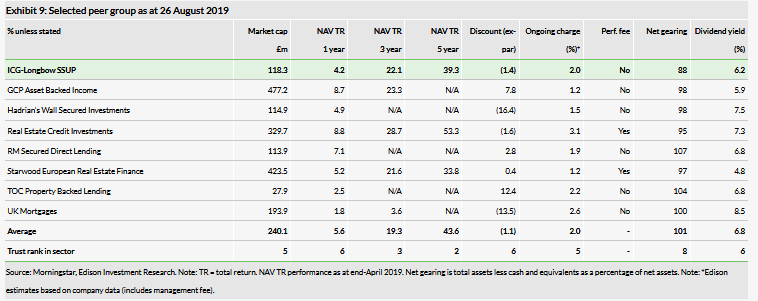
The board
LBOW’s board of directors includes five non-executive members (including the chairman), who are all independent of the company’s investment adviser. Jack Perry, CBE (chairman) is a portfolio non-executive director, being also chairman of European Assets Trust (an equity fund investing in small- and mid-cap public companies in Europe ex-UK) and a non-executive director of Witan Investment Trust (a global equity fund using an active multi-manager approach). Stuart Beevor is a chartered surveyor and an independent consultant with over 30 years of experience. Currently, he serves as a senior independent director of Metropolitan Housing Trust (one of the UK’s leading providers of affordable housing, as well as care and support services) and a non-executive director of Empiric Student Property (an internally managed UK REIT providing and operating direct-let, nominated or leased student accommodation). Patrick Firth is a non-executive director of several investment funds and management companies, such as Riverstone Energy (a closed-end energy investment company) and JZ Capital Partners (investing in US and EU micro-cap companies and US real estate). Paul Meader acts as an independent director of investment companies, insurers and investment funds with over 30 years of experience in financial markets, holding senior positions in portfolio management and trading. Mark Huntley gained more than 40 years of experience in the fund and fiduciary sector, holding several positions in listed and private funds and property advisory boards. He has been actively involved in real estate investment in the UK and internationally and has experience in private and listed debt structures.